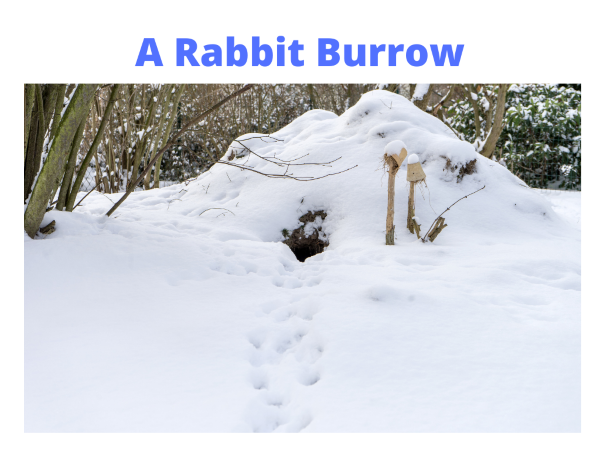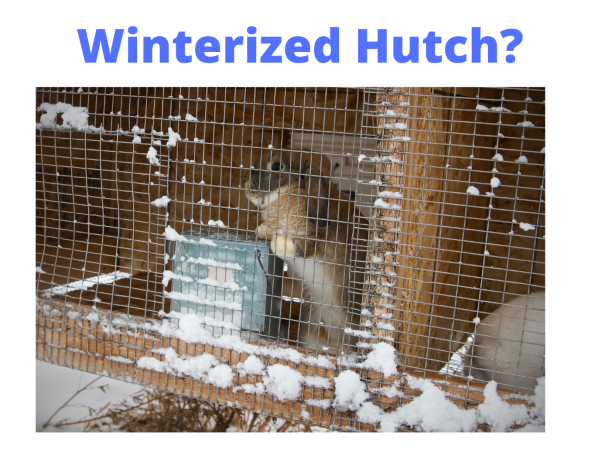At our hobby farm in Pennsylvania we experience all four seasons. The winter season is always notable because it is often pretty cold. When the sun sets and the wind blows hard during cold months, we immediately think of our farm animals, especially our smaller ones such as rabbits.
Many rabbit owners wonder the same thing we do on these winter nights: do rabbits get cold at night?
Healthy domestic Rabbits in their native environment are very “cold hardy” and with proper shelter can typically survive, if not thrive, in the temperature extremes of their natural environments. Similarly, healthy wild rabbits in their natural climate and sheltered in a good burrow or warren (below the frost line) will very likely survive the extremes that mother nature delivers.
Rabbits do not hibernate, instead, they forage through the winter!
Read on to learn about the extreme cold that some rabbits thrive in.
Do Rabbits Get Cold At Night?
When it comes down to it, there are some rabbits that do get cold at night. However, the vast majority of rabbits do not get cold at night.
In fact, cold and dampness can kill some rabbits if they do not have proper housing, which is why proper shelter is so important for rabbits to survive and thrive during cold months.
Do Rabbits Like Cold Weather?
Rabbits generally thrive in cooler climates because they do not sweat and have a nice fur coat. So, rabbits thrive much better in the relatively moderate or cooler seasons of their natural environment than they do in the relatively warmer or hotter seasons of their natural environment.
Fast Fact: Rabbits are mammals that are far more cold hardy than they are heat resistant.
What Temperature Is Too Cold For Wild Rabbits?
Rabbits exist on 6 continents! As such, rabbit species have evolved and adapted to a wide range of climates.
For example, you can find rabbits like the White-Tailed Jack Rabbit (Lepus townsendii) on the arctic tundra of Canada where temperatures plunge to well below -30 F (-34 C), or a rabbit like the Desert Cottontail (Sylvilagus audubonii) in the southwestern United States and Mexico where the temperatures reach well over 110 F (43 C). Without doubt, rabbits have adapted to survive, if not thrive, in the range of temperatures found in its native climates across 6 continents.

Do Bunnies Get Cold At Night?
Yes, we have no doubt that some unfortunate rabbits get cold at night. For a wild rabbit this may be a function of a damp burrow that it dug or spending a bit too much time outside in the twilight of a frigid morning foraging for winter food. For the domestic rabbit, this may be a function of its owner not providing a proper hutch in a wind block or adequate food for the evening.
We stress that cold temperatures are a relative thing, a relative experience, for animals in their native environment. For example, the desert cottontail of the American southwest and Mexico has adapted to the seasonal range of hot and cold temperatures of its environment. However, if it is transported to the harsh winter of the arctic tundra it will quickly become hypothermic and die while trying to forage.
Similarly, the White-Tailed Jack Rabbit has adapted to its seasonal temperature ranges on the frigid tundra. However, if it is transported from the arctic tundra of northern Canada to the searing heat of the Mexican desert it would quickly overheat, experience heat stroke, and die.
So again, in determining if a temperature is extreme for a rabbit, we have to consider the rabbit’s native or indigenous environment and climate.
What Temperature Should Rabbits Come Inside?
The answer to this question depends on the temperature, the wind speed which drives Wind Chill, exposure to the wind, and the amount of dampness.
There is said to be little to no Wind Chill Factor at 50 degreed F (10 C) or above. So, a dry rabbit can stay outside with some wind exposure if it is above 50 F. However, if the rabbit gets wet in a sustained blowing rain or mist at 50 F (10 C) or lower temperature, then that exposed rabbit may die.
This is why dry, adequate shelter from the wind, rain and dampness is critical for rabbits.
If your local weather becomes extreme and you have any doubt about the safety of your outdoor rabbit, then we recommend you err on the side of safety and bring your rabbit into a dry shelter such as a shed or garage until the extreme weather passes. This is another good reason to always have a portable cage or appropriate travel hutch on hand.

Can Rabbits Die From The Cold?
Yes, Rabbits can die from the cold conditions in their natural environments. As described above, if a rabbit is in a damp environment or gets soaked in a downpour of rain or sleet, etc, then it doesn’t take much cold to kill a rabbit. However if the rabbit is in a dry, well sheltered hutch or burrow, then it can withstand some extremely cold temperatures; like the -30 F (-34 C) that rabbits of the Arctic tundra survive each winter.
How Does Cold Weather Affect Rabbits?
Rabbits are mammals, so they are warm blooded. This means that in cold weather rabbits will use more energy to keep their body warm, resulting in rabbits needing to eat and drink more in colder weather than in moderate weather. Unfortunately, rabbits do not store very much body fat.
Furthermore, extremely cold or wet and cold weather will have wild rabbits remaining in their shelters. Rabbits are not able to forage for winter food such as brush, twigs, bark, seedlings, saplings, etc when the weather is at its coldest or when it is wet and cold.
As a result, in periods of sustained winter storms wild rabbits often have to tough it out in their burrows until there is a break in the weather.
Wind Chill And Rabbits
Rabbits are cold hardy, have a nice fur coat, and can generally withstand the coldest seasonal temperatures of their local environment as long as they have dry shelter from the wind.
Two things are definite rabbit killers: a cold wind and a damp and cold environment.
This is because both wind and dampness dissipate the rabbit’s body heat and make it very hard for a rabbit to survive during its cold season.
Wind Chill Factor
The wind blows away body heat and makes it seem colder than the reading on the thermometer.
“The wind chill factor is the temperature felt because of the wind. For example, if a thermometer reads 35 degrees Fahrenheit (2 Celcius) outside and the wind is blowing at 25 miles per hour (40 kmh), the wind chill factor causes it to feel like it is 8 degrees F (-13 C).”
Wind chill is a huge factor and a huge risk for wild animals. They need to find a good, dry wind block.
Rabbits that live in a cold environment have a decent fur coat, but a rabbit’s fur is not like a Husky dog’s fur coat. A Husky or Malamute can curl up and literally become buried during a snow storm, and be just fine. But this would kill a rabbit.
Without a good wind block, most rabbits will NOT survive their natural cold season.
Dry Shelters For Rabbits (Not Damp or Wet)
A rabbit needs a dry environment during cold weather. A damp environment quickly dissipates body heat and we already know that a damp or wet rabbit will not survive long in the cold season.
Do Rabbits Get Cold Outside in Winter?
Yes, rabbits are keenly aware of the temperature and may become cold outside in winter as they forage for winter food. However, if they have a dry home that shelters them from the wind, and some access to food, then a healthy rabbit is likely to survive its winter climate.
Domestic rabbits may also get cold outside in winter. If their shelters are not dry and do not adequately protect them from the wind, then on the season’s colder days they will suffer and may die from exposure.

Do Wild Rabbits Get Cold?
Yes, wild rabbits get cold as they venture out of their dry shelters to forage for winter food. Depending on weather conditions they may be able to endure exposure for only a minute or two while they forage before having to return to their dry shelters.
What A Rabbit Needs to Survive The Cold Winter Nights?
A rabbit needs a good dry shelter with minimal exposure to wind in order to survive the cold winter nights of its native environment.
A Rabbit Hutch or Cage For Winter
Domestic rabbits that are not housed in a climate controlled shelter (like inside our home living spaces) need a dry shelter with as little wind exposure as possible. Most domestic rabbits are not House rabbits, so they live most of their lives in a hutch or cage. The great majority of rabbit hutches and cages are either outside or in a shed or barn that is not climate controlled.
When setting up the location of your outdoor rabbit hutch, consider the predominant winter wind direction, and how dry the location is throughout the stormy seasons of blowing rain, snow, etc.

A Rabbit Burrow or Warren
Many wild rabbits dig a burrow and live in a colony of connected burrows called a warren. Dry burrows and warrens are excellent cold winter shelters for rabbits. The proper burrow or warren provides an excellent wind block; a space where there is no wind.
Additionally, if the burrow or warren is below the frost line, then the ambient temperature in is around 55 degrees F (13 Celsius), and the rabbit’s fur coat is well suited to keep the rabbit nice and warm. Note that a damp burrow will not be suitable for rabbits during winter.

Helpful Hints For How To Keep Rabbits Warm In The Winter
Now that you understand some of the cold weather risks your rabbits face each cold season, here is a list of tips to help you keep your outdoor rabbits warm, dry and healthy during the winter:
- No Wind Zone: Protection from the wind that blows away the rabbit’s body heat. Arrange hutches and cages so that the rabbit is in a no wind zone. The less wind the better. Drafts continually rob rabbits of their body heat.
- Cover the Hutch or Cage With A Blanket or Tarp: If extreme weather is anticipated or happens, then consider covering the hutch or cage with a thick blanket or tarp to help reduce drafts due to extreme weather. Be sure that the rabbit can not reach the blanket or covering so there is no risk of the rabbit chewing and ingesting some of the blanket or covering.
- Dry Location: Protection from damp and wet locations. This includes adequate overhangs or overheads so that driving rain and sleet do not reach the rabbit.
- Ensure Drinking Water Is Available: Rabbits can’t drink ice. If rabbits can’t drink water then they won’t eat hay and pellets. Rabbits that don’t eat well and often, quickly become sick.
- Ensure Adequate High Quality Food: Rabbits will burn more energy keeping themselves warm in the winter. They require more food and it should be of high quality to help them cope with the conditions.
- Add Extra Straw To Hutch and Cage Boxes: Stuffing hutch and cage boxes with a bit of extra straw provides additional bedding and insulation for your rabbits when they huddle in the box.
Do Baby Rabbits Get Cold?
Baby rabbits in their mother’s nest, in a good dry burrow, will typically not get cold. However, if the burrow becomes compromised in some way (wet, damp, or exposed to the wind), then the baby rabbits may get cold and die while their mother is out foraging.
When mother rabbits are about to give birth, they pull out a bunch of their fur and make a nest of hay and fur for their hairless babies. In addition, when the babies are born the mother also keeps them warm with her body.
The baby rabbits are more susceptible to the cold when the mother leaves the nest to forage for food and water. But the ambient temperature in the burrow, the bedding, and their cumulative body heat usually keeps them warm enough until mother rabbit returns.
Finally, rabbits’ natural instincts have them mating so that fewer litters of baby rabbits are born during the coldest season of their local environment.
What Temperature Is Too Cold For Baby Rabbits?
Baby rabbits in a good nest, burrow, or hutch that is dry and sheltered from the wind will stay warm in the coldest temperatures that the local environment offers. Baby rabbits that are compromised by health issues or ones are not in a proper nest, burrow, or hutch may get too cold and perish during their local cold season.
More specifically, a rabbit’s normal temperature ranges from 101.3-104F (38.3-39.4C). If a rabbit’s body temperature gets much below this target range, then it may die within minutes.
Do Rabbits Get Cold Indoors?
The answer to this question depends on what is meants by “Indoors”. For example, when “Indoors” means in a house that a human is living in the rabbit will not be cold. And when “Indoors” means in a garage or shed that is not heated, a healthy and dry rabbit may be a bit chilly but can withstand the cold.
However, a sick rabbit, a rabbit with a pre-existing condition that weakens its immune system, or an older rabbit who may be failing in health will be more challenged by the colder temperatures of the season regardless of where it lives. Such a rabbit will become cold or chilled and die sooner than a healthy rabbit.
The Rabbitry Center is raising rabbits outdoors in Michigan; here’s a great video from the Rabbitry Center titled, “Rabbits In Cold Weather”.
And here’s a very unique video with excellent pictures of what rabbit burrows and warrens look like underground!
Frequently Asked Questions Related To
Do Rabbits Get Cold At Night
Should I Cover My Rabbit’s Cage At Night?
If temperatures are expected to be colder than normal, or at an extreme cold for local conditions, then you may consider covering your rabbit’s cage at night. Again, the primary factors are exposure to wind and dampness. But if the cage or hutch is very well sheltered from air flow and in a dry location, then there is less need to provide extra coverage on extremely cold nights.
How Do I Keep My Rabbit Warm At Night?
To keep your rabbit warm at night check out the bulleted list in this post that includes the following tips:
- Ensure the hutch or cage is in a no wind zone.
- Ensure blowing rain or snow can not enter the hutch or cage.
Do Rabbits Need Blankets At Night?
Domestic rabbits that are used to living in a hutch or cage are likely to chew on blankets, and may end up ingesting some pieces of the blanket. That is not favorable, so we do not recommend blankets in bunny hutches and cages.
However, you may considering covering your outdoor bunny hutch or cage to provide extra protection from wind and blowing precipitation during extreme weather conditions. Be sure that the rabbit can not reach the blanket or covering.
Can Rabbits Get Hypothermia?
Yes, like any warm blooded mammal, rabbits can get hypothermia when they get too cold and their core body temperature drops too low.

Final Thoughts on Do Rabbits Get Cold At Night
Wild Rabbits have evolved to manage well in the cold nights of their local environments. By digging dry burrows and warrens below the frost line wild rabbits create the safe, cozy winter home that helps them thrive through the cold winters.
It is our responsibility to provide the right environment for our outdoor domestic rabbits during cold months, which includes:
- Quality Shelter – Shelter from the harsh seasonal elements with particular emphasis on eliminating wind or draft and ensuring dry spaces. Additional straw in the hutch box for insulation purposes and an additional cover over the hutch are considerations for extreme weather events.
- Quality Food – appropriate food such as unlimited hay or natural treats to fuel the rabbit’s body as it burns more energy to stay warm.
- Quality Water – Rabbits can not drink ice and must have fresh water throughout winter months.
With a little forethought we can provide our outdoor rabbits with all that they need in order to confidently cope with cold nights and our local winter storms!

